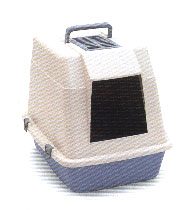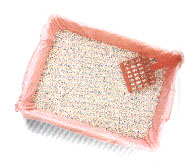Where the king without escort goes
3.1. A toilet corner. A tray for a litter and a scoop
A kitten or an adult cat who are not allowed to go out of doors, should be provided with a plastic tray for a toilet. It is necessary to wash it daily, and to delete the used litter by means of a plastic scoop.
Plastic trays with high sides and the demountable stop that prevents litter scattering when the cat digs in the excrements are convenient in using.
The toilet small house with the extended pallet prevents the smell distribution and the spraying of cat's urine outside the tray limits.
The litter should possess good sucking ability, absorb an unpleasant smell and not to contain asbestos. The wood granulated sawdust has well proved.
Check up, that your kitten could come into the tray chosen by you without effort. If your kitten feels shy to go to a toilet, he can prefer a tray covered from above by a special cover.

PHOTO 3.1.1

PHOTOS 3.1.2
3.2. How many litter boxes are necessary for your kitten?
The cat is very particular about the choice of a place for visiting the necessary. When it squats on hunkers to ease nature, it becomes very vulnerable, and it is quite clear that it is awkward to do it in an open crowded place. As you don't belong to the cat's tribe, you can't decide what corner of its playroom your kitten will prefer as a privy. Therefore it is reasonable to offer it some trays and to put them in different places of the room.
At first you will need at least two trays. As soon as your kitten starts to leave the room and visit other parts of the house, you will need additional trays so if you get them in advance, it will be easier to experiment with their arrangement, and also with versions of the trays. After you realize what your kitten likes more you can reduce the quantity of the exposed trays. All extra trays can be left as a reserve.
3.3. Where is better to put the litter boxes?
We give some advice about the arrangement of trays which you may follow:
• Cats often refuse to use the trays located near the places where they eat, therefore avoid to put trays near the meal and water bowls.
• Avoid any active places, say, near doors or the basic routes which people in the house use more often.
• Avoid open places, insufficiently secret or at all located in full public view.
• Cats often sleep in trays with litter, close to their bedding so don't place trays near the kitten’s favourite places for rest.
• Avoid such places (for example, behind the door) which seem silent and protected but in which a kitten can suddenly be disturbed while it is easing nature.
• All trays should be located in the places available 24 hours a day for a kitten.
• If all available places in your kitten's playroom are too open, think of giving it the closed toilet. Some cats don't like to appear completely closed in narrow space; in this case put a tray under a chair or other furniture where it will be easy and convenient for you to clean for a kitten.
3.4. What kind of hygienic litters for the litter boxes exist?
There is a wide choice of materials for this purpose, including industrial products, and also natural substances like sand and earth. When you bring the kitten to your house first time, fill all trays with the litter which he has got used to at the breeder's place: then you may be sure that if it prefers any certain tray it happens because of its arrangement, not because of its litter.
When you define the locations of trays preferred by your kitten, give it a choice of different litters in the trays put near each other in one place. The majority of cats` owners consider the industrial hygienic litters more convenient. Traditional litters are often made of clay, whereas the modern ones- from such materials as conversion paper products and the granulated wood sawdust.

Photo 3.4.1. Kinds of hygienic litters.
3.5. Advice on a choice of hygienic litter
There are some questions below which should be considered while making a choice of a hygienic litter (some of them have been revealed by experts in behavior of the animals, participating in solving the problems connected with cats` refusal to use litter-boxes).
• Some cats don't like to stand on the granulated litters.
• It was noticed that the litters containing chlorophyll, are unattractive for some cats.
• Some litters can blacken cat's white fur.
• Some litters, especially their versions made of crushed wood, can stick to long fur.
• Some products are packed into water-proof packages or boxes; they are more convenient for storing and easier to use.
• Some structures for litters are developed for smell reduction and contain artificial fragrance components. However the litter smells only when it is left in a tray stained and some cats don't love the litters smelling as deodorants when humidifying.
• The Majority of hygienic litters form lumps at humidifying to absorb a liquid, but some of them crumple better, than others. Such litters appear more economic as all stained litter easily separates from a pure material, and it is not necessary to throw out all contents of a tray so often.
3.6 Litter box clearing and litter recycling
If you overdo with your kitten litter box clearing it can refuse to use them as the smell of its own urine and feces encourages it again to use a toilet. However the majority of cats also refuse to use the litter boxes with already damp or dirty litter.
Frequency with which it is necessary to clear a toilet, certainly, depends on how often kitten uses it, and what sort of litter it contains. However you should release completely each tray and clean it with veterinary disinfectant at least once a week. Don't forget to wash a tray carefully with pure water to remove all smell traces of disinfectant and washing solutions. In intervals between cleanings you should delete clods of dirty litter by means of a special scoop as required.
At litter purchase always familiarize with the instruction on its recycling. There are litters which in no way can be thrown out in the water drain in order to avoid its stoppage. It is possible to throw out some litters in the water drain (for example, the granulated wood sawdust).
At a litter choice be ruled by how comfortable personally for you the recycling of the concrete litter is.
3.7. How to cope with house "troubles"
Even if you overtake your kitten while it eases nature in the wrong place, it is useless to punish it roughly. Moreover, if you frighten it at that moment, it will repeat this "rowdiness" again with more probability. The kitten can think that you forbid to do "it" and will look for secret places to ease nature. Simply carry a kitten to its toilet, and then come back and clean after it.
The smell of urine and excrements are the natural signals inducing your kitten to ease nature, therefore you should thoroughly clean the soiled place: remember that the kitten has sharper sense of smell, than you do. The only places in the house which should smell with urine and excrements is its litter boxes.
For hygienic reasons begin with removal of a great bulk of excrements and then disinfect the soiled place with a veterinary disinfectant solution. Then wash out a stain with the cleaning solution available on sale specially developed for removal of all unpleasant smells. As a last resort, it is possible to use a hot solution of washing powder with biological additives, and then to wipe a stain with the ethanol or the vodka remains.
 BACK
BACK









